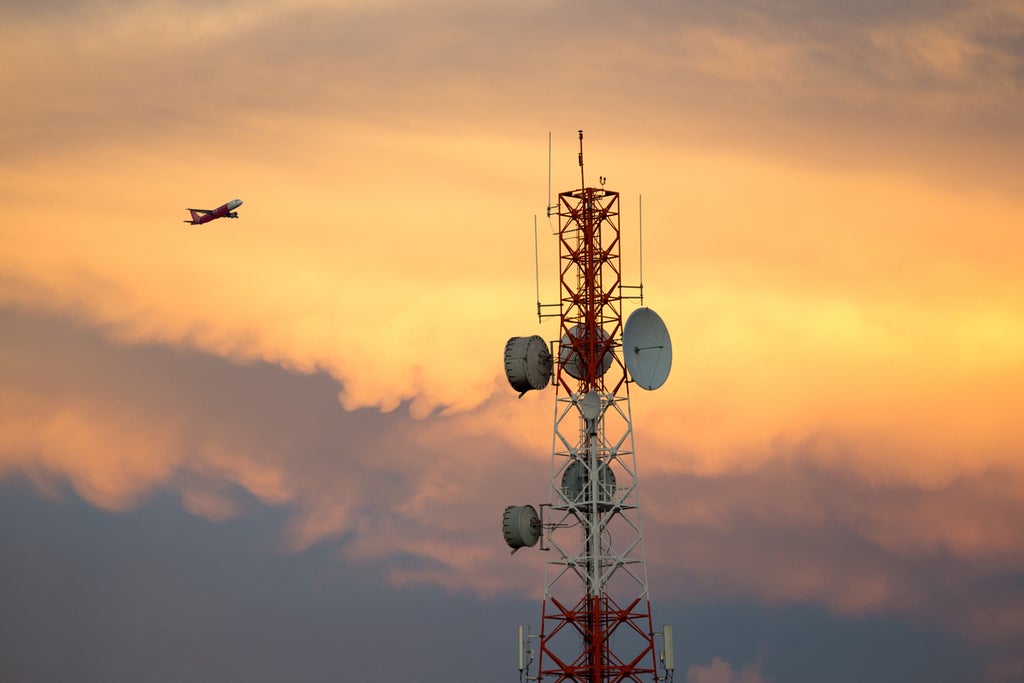
Following a flurry of headlines about the delay to the rollout of high-speed 5G internet in the US, many travellers have concerns about its potential effect on flight safety.
In early January, US mobile networks Verizon and AT&T agreed to push back their 5G rollouts – originally planned for December – until 19 January over aviation concerns, following a request from US transportation secretary Pete Buttigieg and the Federal Aviation Administration (FAA).
However, this week top airline executives sent a letter to Buttigieg and other federal officials, saying in no uncertain terms that if the rollout goes ahead this week as planned, it could be “catastrophic” for the aviation industry.
On 18 January both AT&T and Verizon said they would delay activating 5G masts near airports, although others would go ahead as planned.
So should air passengers be worried about the dawn of 5G?
Here’s everything we know so far.
How could 5G affect flights and planes?
High-speed 5G internet uses what’s called “C-band frequencies”, which are similar to those used by modern aircraft to measure altitude.
Airline bosses claim that the arrival of 5G could interfere with these aircraft instruments and cause disruption to flights.
There are particular concerns about radio altimeters, which tell pilots their altitude as they fly in low visibility.
Operators of air ambulances in the US have also raised concerns, since commercial helicopters often use a device called a radar altimeter to ensure safe landings.
In turn, the mobile networks argue that the aviation industry has had years to upgrade their instruments.
Some aviation leaders are asking for 5G to be delayed in areas around US airports.
Concerns have already been addressed - at least partly. The FAA said earlier this month that it would not object to a rollout of 5G after the technology companies concerned agreed to reduce power at 5G transmitters near airports for the first six months after the rollout.
However, it also announced in December that flights that rely on a radio altimeter might need to be rescheduled if there was a risk of 5G interference, effectively pitting the mobile networks against the airline industry.
On 19 January the aviation body announced that it has cleared several kinds of radio altimeter used by US aircraft, meaning that around 62 per cent of US commercial aircraft now have clearance for low-visibility landings at airports close to 5G transmitters.
However “even with these new approvals, flights at some airports may still be affected,” they confirmed.
“Passengers should check with their airlines if weather is forecast at a destination where 5G interference is possible.”
Boeing 787s are particularly affected, with the FAA confirming last week: “During the two-week delay in deploying new 5G service, safety experts determined that 5G interference with the aircraft’s radio altimeter could prevent engine and braking systems from transitioning to landing mode, which could prevent an aircraft from stopping on the runway.”
This could mean delays or cancellations for this type of aircraft where it would need to land in poor-visibility conditions close to a 5G transmitter.
Who is asking for 5G to be delayed further?
An open letter was published on 17 January by the chief executives of Delta Air Lines, American Airlines, United Airlines and Southwest, as well as six other passenger and cargo carriers.
The collective warned that, if the C-Band 5G service went ahead on 19 January, it “could potentially strand tens of thousands of Americans overseas”.
The letter, attributed to Airlines for America and signed by the various aviation bosses, claimed the rollout would cause “chaos” in general for US aviation.
“Immediate intervention is needed to avoid significant operational disruption to air passengers, shippers, supply chain and delivery of needed medical supplies,” urges the letter.
“Airplane manufacturers have informed us that there are huge swaths of the operating fleet that may need to be indefinitely grounded.
“Multiple modern safety systems on aircraft will be deemed unusable.
“This means that on a day like yesterday, more than 1,100 flights and 100,000 passengers would be subjected to cancellations, diversions or delays.
“To be blunt, the nation’s commerce will grind to a halt.”
The aviation bosses asked that 5G transmitters not be activated within a two mile radius of 50 major US airports.
They say that the FAA needs more time to research how closer 5G transmission could be deployed without resulting in “catastrophic disruption”.
What was the outcome?
As of 18 January, AT&T and Verizon have both agreed to reduce their 5G deployment around some or all airports.
On Tuesday an AT&T spokesperson said some 5G services near airports would be delayed, although others would go live as planned.
She added: “We are frustrated by the FAA’s inability to do what nearly 40 countries have done, which is to safely deploy 5G technology without disrupting aviation services, and we urge it do so in a timely manner.”
Verizon said it had “voluntarily decided to limit our 5G network around airports”.
The FAA released a statement on Monday saying it “will continue to keep the travelling public safe as wireless companies deploy 5G” and emphasising that it “continues to work with the aviation industry and wireless companies to try and limit 5G-related flight delays and cancellations.”
The plan is that the FAA will lift restrictions on aircraft one by one, as airlines prove their altimeters can work when the C-band technology is turned on.







